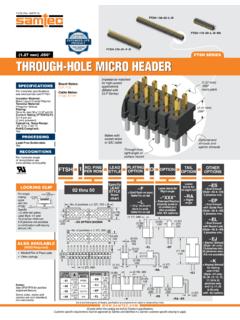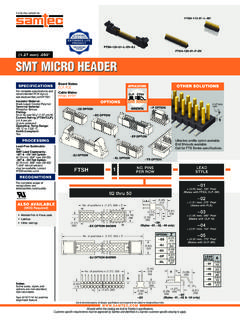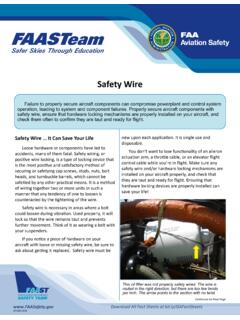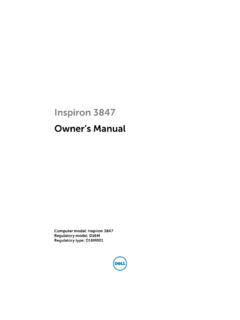Transcription of Compact I/O 1769-IF8 Analog Input Module Installation ...
1 Publication 1769-IN067B-EN-P - September 2005 Installation InstructionsCompact I/O 1769-IF8 Analog Input ModuleInsideModule Description .. 2 Module 3 System 4 Mounting Expansion I/O .. 5 Replacing a Single Module within a System .. 7 Module Spare/Replacement Parts .. 8 Field Wiring 8I/O Memory Mapping .. 13 Specifications ..24 Hazardous Location 27 Environnements dangereux .. 27 For More Information .. 282 Compact I/O 1769-IF8 Analog Input ModulePublication 1769-IN067B-EN-P - September 2005 Module DescriptionItemDescription1bus lever (with locking function)2aupper panel mounting tab2blower panel mounting tab3module status LED4module door with terminal identification label5amovable bus connector with female pins5bstationary bus connector with male pins6nameplate label7aupper tongue-and-groove slots7blower tongue-and-groove slots8aupper DIN rail latch8blower DIN rail latch9write-on label (user ID tag)
2 10removable terminal block (RTB) with finger-safe cover10aRTB upper retaining screw10bRTB lower retaining screw10a10b41032a12b5a97a7b8b7b8a7a5b6 NCV in 2+ANLG ComANLG ComANLG ComANLG ComANLG ComANLG ComANLG ComANLG ComV/I in 3-V/I in 2-V/I in 1-V/I in 0-V in 0+NCI in 3+V in 3+I in 2+I in 1+V in 1+I in 0+NCV in 6+V/I in 7-V/I in 6-V/I in 5-V/I in 4-NCI in 7+V in 7+I in 6+I in 5+V in 5+I in 4+V in 4+ 1769-IF8 WARNING -Do NotRemove RTB UnlessArea is Non-HazardousOKAnalogINPUTC ompact I/O 1769-IF8 Analog Input Module 3 Publication 1769-IN067B-EN-P - September
3 2005 Module InstallationCompact I/O is suitable for use in an industrial environment when installed in accordance with these instructions. Specifically, this equipment is intended for use in clean, dry environments (Pollution degree 2(1)) and to circuits not exceeding Over Voltage Category II(2) (IEC 60664-1).(3)Prevent Electrostatic DischargeRemove Power(1)Pollution Degree 2 is an environment where, normally, only non-conductive pollution occurs except that occasionally a temporary conductivity caused by condensation shall be expected.
4 (2)Over Voltage Category II is the load level section of the electrical distribution system. At this level transient voltages are controlled and do not exceed the impulse voltage capability of the product s insulation.(3)Pollution Degree 2 and Over Voltage Category II are International Electrotechnical Commission (IEC) discharge can damage integrated circuits or semiconductors if you touch bus connector pins or the terminal block. Follow these guidelines when you handle the Module : Touch a grounded object to discharge static potential.
5 Wear an approved wrist-strap grounding device. Do not touch the bus connector or connector pins. Do not touch circuit components inside the Module . If available, use a static-safe work station. When not in use, keep the Module in its static-shield power before removing or inserting this Module . When you remove or insert a Module with power applied, an electrical arc may occur. An electrical arc can cause personal injury or property damage by: sending an erroneous signal to your system s field devices, causing unintended machine motion causing an explosion in a hazardous environmentElectrical arcing causes excessive wear to contacts on both the Module and its mating connector.
6 Worn contacts may create electrical Compact I/O 1769-IF8 Analog Input ModulePublication 1769-IN067B-EN-P - September 2005 System AssemblyThe Module can be attached to the controller or an adjacent I/O Module before or after mounting. For mounting instructions, see Panel Mounting on page 6, or DIN Rail Mounting on page 7. To work with a system that is already mounted, see Replacing a Single Module within a System on page following procedure shows you how to assemble the Compact I/O that the bus lever of the Module to be installed is in the unlocked (fully right) the upper and lower tongue-and-groove slots (1) to secure the modules together (or to a controller).
7 The Module back along the tongue-and-groove slots until the bus connectors (2) line up with each the bus lever back slightly to clear the positioning tab (3). Use your fingers or a small I/O 1769-IF8 Analog Input Module 5 Publication 1769-IN067B-EN-P - September allow communication between the controller and Module , move the bus lever fully to the left (4) until it clicks. Ensure it is locked firmly in an end cap terminator (5) to the last Module in the system by using the tongue-and-groove slots as before. the end cap bus terminator (6).
8 Mounting Expansion I/OMinimum SpacingMaintain spacing from enclosure walls, wireways, adjacent equipment, etc. Allow 50 mm (2 in.) of space on all sides for adequate ventilation, as shown:ATTENTIONWhen attaching I/O modules, it is very important that the bus connectors are securely locked together to ensure proper electrical 1769-ECR or 1769-ECL right or left end cap must be used to terminate the end of the communication panel or DIN rail mounting of all devices, be sure that all debris (metal chips, wire strands, etc.) is kept from falling into the Module .
9 Debris that falls into the Module could cause damage on power pBottomSideSideHost ControllerCompact I/OCompact I/OCompact I/OCompact I/OCompact I/OEnd Cap6 Compact I/O 1769-IF8 Analog Input ModulePublication 1769-IN067B-EN-P - September 2005 Panel MountingMount the Module to a panel using two screws per Module . Use M4 or #8 panhead screws. Mounting screws are required on every Mounting Using the Dimensional TemplatePanel Mounting Procedure Using Modules as a TemplateThe following procedure allows you to use the assembled modules as a template for drilling holes in the panel.
10 If you have sophisticated panel mounting equipment, you can use the dimensional template provided on page 6. Due to Module mounting hole tolerance, it is important to follow these a clean work surface, assemble no more than three the assembled modules as a template, carefully mark the center of all Module -mounting holes on the the assembled modules to the clean work surface, including any previously mounted and tap the mounting holes for the recommended M4 or #8 the modules back on the panel and check for proper hole the modules to the panel using the mounting steps 1 to 6 for any remaining mounting more modules.














